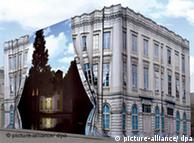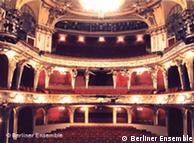Pop and Rococo Meet and Greet

Todd Heisler/The New York Times
John Wesley at his Venice opening on Friday.
Published: June 8, 2009
VENICE — For more than 40 years the art world has never known quite what to do with John Wesley and the paintings that seem to tumble out of his dreams.
Skip to next paragraph 
The latest on the arts, coverage of live events, critical reviews, multimedia extravaganzas and much more. Join the discussion.

Images courtesy of the artist/Fredericks & Freiser Gallery
“The Mouse Tells Jokes” (2002).
Early on it classified him as a Pop artist, a label that sat uncomfortably. “But I accepted it because it got me into a lot of shows,” said Mr. Wesley, now 80. He has also been called an insurgent Minimalist, largely because of Donald Judd’s admiration for his work and Mr. Judd’s enshrinement of it alongside some of the most important examples of Minimalism at the Chinati Foundation in Marfa, Tex.
The critic Dave Hickey, in an ecstatic essay in 2000, even launched a rear-guard action for Mr. Wesley as a 20th-century extension of Rococo, putting him in the company of Boucher and saying of his relative lack of prominence among the great postwar painters: “Those who know know; those who care care; those who don’t know or care don’t have a clue, but that’s O.K., too.”
Many more people will undoubtedly know and care about Mr. Wesley now, as a result of a blockbuster retrospective, organized by the renowned Italian curator Germano Celant under the auspices of the Prada Foundation, that opened here on Friday in conjunction with the Venice Biennale.
The show, which runs through Oct. 4, is only the second major survey of Mr. Wesley’s bright, funny, relentlessly flat and often unsettlingly erotic work, after a well-received retrospective nine years ago at the P.S. 1 Contemporary Art Center in Queens. The new exhibition, spread out through the cavernous rooms of two former boarding-school buildings on the island of San Giorgio Maggiore, has brought together three times as many works, more than 150 dating to the early 1960s, when Mr. Wesley, who had moved to New York from Los Angeles, was still working at the post office. (He once described that job equably as “a very polite prison, full of very decent prisoners.”)
When he arrived in Venice last week and had a chance to look at some of his older paintings for the first time in decades — many are in collections in Europe, where his early following was much stronger than in the United States — he grew a little teary.
“I’m really looking forward to seeing those,” he had said shortly before leaving for Italy, sitting in his sunny, rambling apartment and studio near Washington Square in Greenwich Village. “I want to make sure they’re mine,” he added with his characteristic dry wit.
Mr. Wesley, who grew up in Los Angeles, had a difficult childhood and no formal art training before deciding to become a painter. When he was 5, his father died of a heart attack on the family’s bathroom floor, and Mr. Wesley ended up briefly in an orphanage, returning home to a demanding stepfather. Before the post office, he worked as a dishwasher and later as a draftsman for the Northrop aircraft company, interpreting blueprints, an experience that contributed to the dark, matte industrial blues of his early paintings.
Though he has described himself as a loner, he has nearly always been alone in a crowd of fellow artists. He was close to Ed Kienholz in Los Angeles, and his second wife was the painter Jo Baer. Besides Mr. Judd, he has counted Dan Flavin and Robert Ryman as friends, and in a published conversation with Alanna Heiss, the curator of his P.S.1 show, he recounted once making an impromptu beer delivery to Willem de Kooning’s studio, where the two men talked about their shared susceptibility to anxiety attacks.
But Mr. Wesley has always been very uncomfortable talking about himself or his painting, a reticence that may also have contributed somewhat to his below-the-radar reputation. The writer Hannah Green, his third wife, wrote that he made it a “rule never to talk about his work and above all not to catch himself sounding eloquent.”
A tall, slightly stooped man dressed like a Sunday gardener in a chambray shirt and New Balance running shoes, he was courtly and funny during the interview of almost two hours while managing to answer almost no questions about the visual obsessions that return again and again in his paintings: dogs, birds, airplanes, floating babies, lithe pink women and cartoon characters like Popeye, Olive Oyl, Dagwood and Blondie.
With titles like “Hungarian Dog Wrestler,” “Debbie Millstein Swallowed a Thumbtack” and “Bumstead in Bedlam,” they can suggest old blues songs sprung surreally into the visual world, a kind of postmodern channeling of the “old, weird America” written about by Greil Marcus and mined by Bob Dylan.
The critic Ken Johnson, a frequent contributor to The New York Times, wrote in Art in America that it is “as though the clichés of popular culture had been dipped in the pool of the artist’s unconscious and come out soaked with private meanings, associations and feelings.”
Asked about such interpretations and about often being described as a surrealist — the curator Mr. Celant said he has always seen the strong influence of de Chirico and Magritte — Mr. Wesley shrugged. “I didn’t go out and try to be a surrealist,” he said. “It was just fun doing what I was doing.”
Hanging on the wall of the apartment near his desk that afternoon was a meaty-looking canvas slathered with paint that looked nothing like a Wesley. He explained that he had made it when he was very young, under the influence of Soutine, before he discovered the work of Jasper Johns and other post-Abstract-Expressionist artists and radically changed course. He was relieved, he said, that the old painting had his son’s name written all over the back of it: “That way if I croak, it won’t go into my body of work — it will go back him.”
Mr. Wesley begins his paintings by tracing images, often fashion or news photos, from magazine and books. As the tracings are transformed into gouaches and then into acrylic paintings, the elements morph, often becoming reversed or repeated, and the forms are stripped down, rendered more rubbery and stylized.
Eyelashes can come to look like black webbing. Baseball gloves can be mistaken for ears or maybe vaginas. Dagwood might disappear altogether, with just an empty speech bubble left floating in the room to indicate its sad-sack source. (“It’s magic,” Mr. Wesley deadpanned during the interview, as Jessica Fredericks, his dealer, held up a recent tracing he had made from a clipped newspaper photograph of Condoleezza Rice. Mr. Wesley said he had simply been struck by the form of Ms. Rice’s face, but added: “I like Condi. I hope they don’t put her in jail. She just got in with the wrong crowd.”)
Asked how he would describe himself as a painter, he burst out laughing and said, “I have absolutely no idea.”
“But I seem to have found my own place,” he said, “which I’m thankful for.”
Outside the gallery on San Giorgio Maggiore on Friday night, as he made his way through the admiring, well-heeled crowd pressing around him, he looked as if he were longing for a nice, quiet corner to hold down. But he was smiling more often than not, and at one point gazed over the water toward the heart of Venice, then up at the huge exhibition sign that faced it, emblazoned with his name.
“Well,” he said, “this is really something, isn’t it?”











![[British Museum Garden]](http://s.wsj.net/public/resources/images/EW-AG797_toppic_D_20090506151616.jpg) The Trustees of the British Museum
The Trustees of the British Museum